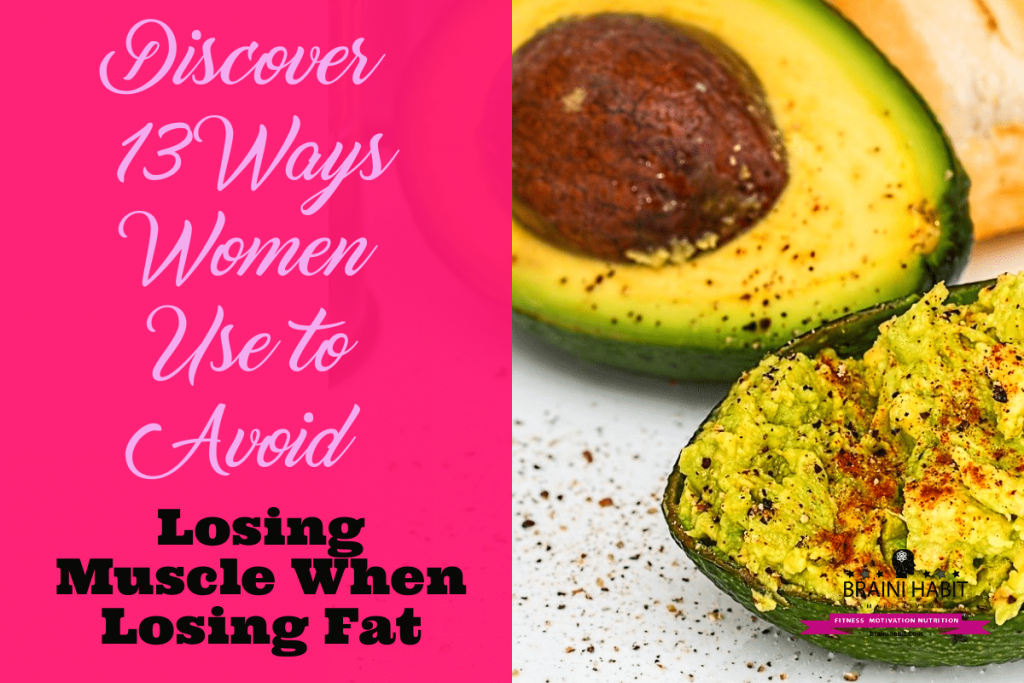Every year, millions of women hit the gym to burn fat and become fit. During their weight loss journey, many of them end up losing precious muscle mass.
Burning fat, without losing muscles is like a pipe dream to a lot of women.
But several fitness experts and scientific evidence have shown that it is possible to burn fat without losing muscles.
Below are some science-backed ways to lose those excess pounds without sacrificing your hard-earned muscles.
Before we dive right into that, we are first going to be looking at how fat and muscle loss happens.

- The truth behind fat and muscles loss
- 1. Reduce your caloric intake gradually
- 2. Ensure that you are getting the right pre and post workout nutrition
- 3. Eat enough protein
- 4. Engage in strength training exercises
- 5. Calorie cycling and refeeds
- 6. Take a break from your diet
- 7. Limit weight training intensity and frequency
- 8. Ensure that you are getting enough sleep
- 9. Eat lots of fruits and vegetables
- 10. Don’t do too much cardio (cut it out if you can)
- 11. Drink more vinegar
- 12. Eat foods that are rich in fiber
- 13. Ensure that you are taking enough BCAAs
- The bottom line on losing fat without losing muscle
The truth behind fat and muscles loss
For fat loss to occur, your caloric intake needs to be less than that amount of calories your body needs.
When this happens, your body will use stored body fat as an alternative energy source.
This is known as a caloric deficit.
Ideally, your body ought to burn only the excess body fat while in a caloric deficit. But, it turns out that there is another source of energy in your body- your muscles.
What this means is that your body can choose to use either fat or muscles or both of them when you are in a caloric deficit. You have no direct control over the one it picks.
The goal of your body is to prevent you from starving. And it does this by using stored energy.
However, there are strategic ways you can tweak your workout and diet to increase the odds of it burning fat instead of muscles.
Take away
To lose fat, you need to eat less than the amount of calories your body needs. Your body can either choose to use stored fat or muscle mass as an energy source to cover a caloric deficit.
1. Reduce your caloric intake gradually
As previously mentioned, you need to have a caloric deficit before you can lose fat. What this means is that you need to reduce the amount of food you consume to some extent.
While you have the freedom to go all-out and reduce the amount of food you consume dramatically, it is best you gradually reduce it.
Studies have shown that creating a moderate deficit is ideal for fat loss for a plethora of reasons, including muscle preservation (1)(2).
So, if your maintenance level is 2000 calories and you need to create a 20-25% caloric deficit, you should consume about 1300 to 1500 calories daily.
Why creating a larger deficit isn’t the answer
At this point, you are likely wondering why creating a large caloric deficit isn’t recommended by fitness experts, as it can speed weight loss.
Well, the problem with creating a large caloric deficit is that it can hurt your goal of losing only fat.
Even more, it can result in the following issues.
- Hunger
- Fatigue
- Mood swings
- Slow metabolism
- Low sleep quality
- Low libido
- Weak bones
Take away
To ensure that you don’t lose those precious muscles, aim for a caloric deficit between 20 to 25% less than your maintenance level. Anything more may result in serious health issues.
2. Ensure that you are getting the right pre and post workout nutrition
The meals you consume before and after working out are super important, as they can improve your performance during a workout session, speed up your recovery time, and boost your overall result.
Eating nutritious food is critical to fat loss and muscle building/maintenance (3).
But the time to eat them is also important.
Research has shown that eating the right food before and after working out offers a lot of benefits, including muscle building (4) (5).
As you likely know, your performance during a workout will reduce while you are in a deficit, as you are eating way less than the amount of calories your body needs to carry out its functions.
So, if you aren’t getting the right post-workout nutrition, you may lose your precious muscles.
A good amount of carbs and protein should be part of your pre and post-workout meals. (6)
Take away
Consume protein-rich meals before and after working out. Doing this will go a long way to help prevent muscle loss and encourage muscle gain.
3. Eat enough protein
Consuming enough protein daily is the single most important thing you can do to maintain your muscles.
Several studies have shown how a high protein diet can promote fat loss without muscle loss (7) (8) (9) (10) (11).
Even if you aren’t lifting heavy or following a weight training routine, you will only lose fat if your protein intake is very high.
Bear in mind that consuming too much protein may result in some health issues. Balance is the key here.
To create a balanced muscle building and maintenance diet, you first need to eat the right amount of protein daily.
Research has shown that eating between 0.8 to 1.5 grams of protein for each pound of your body weight is enough to prevent muscle loss (12)(13)(14).
Don’t use your current bodyweight for this calculation if you are obese. Instead, use the bodyweight goal you are working towards.
Take away
Ensure that your diet is loaded with protein-rich food like eggs, fish, nuts, milk, beans/legumes and lean meat. And try to consume between 0.8 to 1.5 grams of protein for every pound of your body weight.
4. Engage in strength training exercises
It’s no news that a good weight training program can encourage fat loss and prevent muscle loss.
But what may interest you is how lifting heavy and increasing your strength helps to prevent your precious muscles from going away.
The bodybuilding process is a gradual one and is stimulated by a progressive overload (14). In simple terms, this means increasing the amount of weight you carry gradually.
So, for example, if in your first month of training you used a 15 kg weight during your workout, and progressed to a 25 kg weight in your second month and a 35 kg weight in your third month, your body will build more muscles so that you can lift more.
However, if you are using the same weight and doing the same number of rep for a couple of months, your body won’t build more muscles, as you aren’t challenging it enough.
This concept also applies to muscle maintenance (15).
The bottom line is that the nature of your workout can send signals to your body to keep its current muscle mass.
Take away
Make it your goal to maintain or increase your strength level as you lose weight. Doing this will signal your body to either keep your present muscle mass or build more muscle.
5. Calorie cycling and refeeds
As previously mentioned, a caloric deficit is critical to weight loss. However, a large or prolonged deficit can result in a handful of health issues.
Even worse, it can lead to muscle loss.
The good news is that there are some ways to mitigate these effects and even reverse them.
Below are some of them.
- Calorie cycling
- Refeeds
Calorie cycling and refeeds creates a window for us to temporarily stop our caloric deficit by eating carbs. This, in turn, will help us get to our maintenance level (16).
Here is how to do it.
Refeeds
There are several ways you can do this and at several time frames, but if you are new to it, you should stick to the 24-hour time frame.
During this time, you can choose to eat between your maintenance level and a few hundred calories above it. (Not more than 500 calories)
Calorie cycling
This is primarily doing reefed 2-3 times weekly.
Both methods can help reduce the issues associated with a prolonged caloric deficit and prevent us from losing muscles as we burn fat (17) (18).
Take away
Reduce the effects of the prolonged caloric deficit by incorporating either caloric cycling or refeeds. Both can also help to prevent muscle loss.
6. Take a break from your diet
The importance of following a diet cannot be overemphasized, especially when it comes to fat loss.
But, do you know that taking a break from your diet can help you achieve your fitness goal?
Studies have shown that a full diet break can help prevent muscle loss (19) (20).
A diet break is a period (usually 1-2 weeks), where you step out of your deficit and eat up to your maintenance level.
During this period, you will recover from the issues associated with creating a caloric deficit like fatigue and hormonal adaptation. This, in turn, will help prevent muscle loss.
While you have the freedom to choose how often you are going to have a diet break, you should have it once every 7 to 16 weeks.
If you are close to achieving your weight goal, then you can do it once every 6-12 weeks. If, on the other hand, you aren’t close to it, you should do it once every 10-16 weeks.
Take away
Take a break from your diet once every 7 to 16 weeks. Increase your calorie intake during this period by adding carbs to your diet, but don’t go above your maintenance level.
7. Limit weight training intensity and frequency
While under a caloric deficit, your energy level is going to drop.
This isn’t a bad thing, as it will encourage fat loss.
However, during the deficit period, your weight training performance and energy levels will reduce.
The reason for the decline is linked to your energy deficit.
Note that even a moderate deficit can trigger a drop in performance and recovery time. And if you keep pushing yourself, you are going to lose strength and muscle.
So, if you are following a workout program that has high frequency or volume, while under a calorie deficit, you are going to notice the following.
- A decrease in reps and overall performance
- Longer recovery time
- Fatigue
While all this is happening, your precious muscles will slowly ebb away.
To prevent this, you have to reduce the frequency and intensity of your weight training program.
Take away
Your energy level is going to plummet while in a deficit. Reducing the intensity and frequency of your weight training workout during the deficit period will help you prevent energy and muscle loss.
8. Ensure that you are getting enough sleep
Having a comprehensive recovery plan is just as important as working out and eating right, as it can encourage fat loss and prevent muscle loss.
A study that was published in 2018 shows that losing a single hour of sleep can reduce the amount of fat your body can burn.
Another study shows that lack of quality sleep may lead to increased appetite (21). This will make it difficult for you to eat below your maintenance level.
While you sleep, a couple of important things happen to your body.
According to the National Sleep Foundation, HGH (human growth hormone) is produced by our bodies to increase muscle growth while we sleep. Blood flow to the muscles increases dramatically during this time to help repair the tissues damaged during a workout.
Granted, we all have different sleep demands. Since your goal is to lose fat and retain your muscles, then you should try to get between 7 to 9 hours of sleep each night.
Take away
Getting enough sleep is just as important as working out and eating right. Sleeping for 8 hours each night will help you recover quicker.
9. Eat lots of fruits and vegetables
No diet is complete without fruits and vegetables, as they are low in calories but rich in important nutrients that our body needs.
Incorporating fruits and veggies to your meal plan isn’t only going to help you burn fat, but will also help you recover quicker (22).
One study shows that taking 5 servings of vegetables and fruits can promote weight loss (23).
If you are looking to lower the number of calories you consume, to create a deficit, then you should add veggies and fruits to your diet.
Since they are low in calories, they are the perfect addition to your diet.
Aside from promoting fat loss, fruits and veggies can also protect your muscles.
While in a deficit, your energy level will gradually reduce. Because of this, it will take a longer time for you to recover. And during this time, you are likely going to lose muscles.
Eating enough fruits can help your body recover quicker, thus preventing your body from dining on your precious muscles.
Take away
Fruits and vegetables have a lot of health benefits, including promoting weight loss. Eating 4 to 6 servings of fruits and veggies can help cut down your recovery time.
10. Don’t do too much cardio (cut it out if you can)
To achieve your goal of burning fat without losing your muscles, you have to reduce or cut out cardio from your training regime.
Doing cardio, while following a weight training program, is a recipe for muscle loss, as it will add strain on your body.
When this happens, it will take a longer time for your body to recover.
With extended recovery time, your strength and performance will suffer. And when this happens, your body may not be able to burn fat while maintaining muscles.
Don’t forget that the body parts used for cardio (usually our legs and nervous system) can affect our entire body.
Weight training is pivotal for muscle building and maintenance. Cardio, on the other hand, is not.
Cardio is great for general weight loss, not for muscle building and maintenance. The less cardio you do, the better.
Take away
Do as less cardio as possible. If possible, cut it out of your training regime, as it can hurt your recovery time.
11. Drink more vinegar
Vinegar is a great addition to any diet.
Taking a considerable amount of it daily can improve your overall health, maintain your muscles, and help you lose weight.
In fact, one study found that taking two spoons of vinegar on a daily basis can help people burn belly fat and lose weight (24).
The result of some research has shown that vinegar helps control blood sugar and encourages fat burn (25).
Drinking vinegar can also help you create a caloric deficit. Even more, it can help prevent some of the negative effects of the deficit like fatigue and hunger.
Vinegar can also help reduce your appetite and make you feel full (26).
A small study conducted not too long ago showed that vinegar can reduce calorie intake.
The number of calories consumed by the 11 participants of the study reduced by more than 275 calories when they started drinking vinegar (27).
The good thing about vinegar is that it is super easy to add to any diet. For example, you can add it to your beverage or to water and drink it a few times a day.
Take away
Taking 1-2 tablespoons of vinegar can help you lose weight. It can also help reduce your appetite and make you feel full.
12. Eat foods that are rich in fiber
Fiber is a vital nutrient that your body needs to carry out its daily functions.
A lot of people overlook it or write it off as unimportant. But the truth is that it is one of the key nutrients your body needs.
Research has shown that consuming some type of fiber can have a positive impact on your metabolism, weight, and overall health. (28)
Food like oats, beans, asparagus, and Brussels sprouts are very rich in fiber. Some studies suggest that fibers from whole plant food are somewhat better than those in fiber supplements.
If you plan on introducing more fibers to your diet, do it slowly.
Taking too much fiber at once can result in health conditions like diarrhea and abdominal cramps.
Note that viscous and soluble fiber supplements are not great for weight loss (29).
On the other hand, viscous fibers, which are gotten from konjac root, can help you lose weight and retain your muscles (30) (31) (32).
To get the most out of fiber supplements, you have to combine it with a good diet and workout program.
Take away
Fiber contains essential nutrients our body needs to function. A high fiber diet can promote weight loss and prevent a lot of illnesses.
13. Ensure that you are taking enough BCAAs
BCAAs stand for Branched Chained Amino Acids.
They are essential for muscle maintenance and growth. Their chemical structure is somewhat similar to that found in eggs, meat, and other food that are rich in protein.
BCAA can stimulate the muscle-building process (33) (34).
In one study, a participant who drank 5.6g of BCAAs after working out had a 22% increase in their muscle compared to other participants who took a placebo drink (35).
According to some research, BCAAs can help speed up recovery after a workout. It does this by reducing the rate at which protein is broken down when we workout. (36)
So, taking BCAAs before working out can help cut down your recovery time. (37) To get the most out of it, you have to take other essential amino acids that are found in whey (38) (39).
BCAAs can also help prevent muscle loss, which is likely going to occur while you are in a deficit (40).
Take away
BCAA is an excellent supplement that can help prevent muscle loss. Taking BCAA regularly can also help increase muscle growth.
The bottom line on losing fat without losing muscle
There you have it… the most effective ways to lose fat without your losing muscles in the process.
Of course, you can choose to apply a couple of the tips discussed in this article. But, if you want to get the best results; you have to implement all of them, as they are all important.
And remember that weight loss isn’t a sprint, but a journey. So, take your time, plan, strategize, eat right, and work hard.
Your body will reward you.





